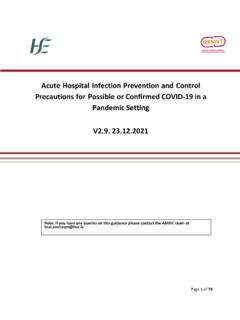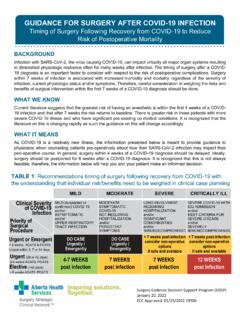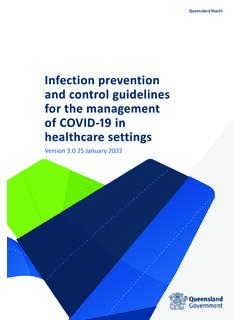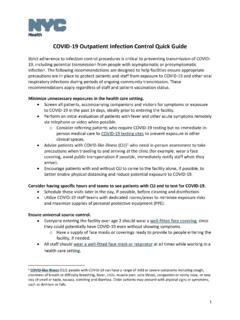Transcription of Nursing Home COVID-19 Infection Control Assessment and …
1 CS 327800-A | 12/20/2021 Nursing HOME COVID-19 Infection Control Assessment AND RESPONSE (ICAR) TOOL FACILITATOR GUIDE | VERSION |How to use this ICAR toolThis tool is intended to help assess Infection prevention and Control (IPC) practices in Nursing homes without an active outbreak of COVID-19 . However, public health jurisdictions may choose to modify this tool to fit their needs beyond this defined scope ( , modifications to assess facilities experiencing an outbreak). The tool is divided into ten sections:Section 1: Collects facility demographics and critical infrastructure information and is intended for completion by the facility prior to the ICAR (provided as separate PDF to send to facility: ). These questions are often ones that require the facility to look up or consult with certain staff members and thus pre-collection often saves time during the actual Assessment . The ICAR facilitator should decide if any of the responses need to be verbally reviewed or require further explanation at the beginning of the Assessment .
2 If no further clarification is needed, then the facilitator should start on the next section and refer to this section as needed. Section 1 of the facilitator guide provides the rationale behind the questions and how the answers may be utilized during the rest of Assessment . Sections 2-9: Are intended for review during a discussion of policies and practices with the facility. These sections cover personal protective equipment (PPE), hand hygiene, environmental cleaning, general IPC practices, resident-specific practices, SARS-CoV-2 testing, and evaluation of healthcare personnel, residents and visitors. The questions are formatted to include: Scenarios such as what type of PPE would be used in certain situations Closed-ended questions with yes/no response options Open-ended questions which prompt for more descriptive responses For the open-ended questions, common responses are often listed below each question to aid in data collection but may contain answers that would not be considered a recommended IPC practice.
3 The facilitator guide should be consulted for the recommended IPC 10: Is intended for use during an in-person or video tour of the facility and includes a review of screening areas, hand hygiene supplies, PPE use and storage, frontline healthcare personnel (HCP) interviews, breakrooms, and a designated COVID-19 care area. These sections are meant to assess how some of the discussed policies and practices are being implemented. If this tool is being used as part of an in-person Assessment , additional areas and observations of HCP practices may be assessed beyond what is listed in this tool. This facilitator guide provides some additional instructions for the use of these sections. 2 ContentsHow to use this ICAR tool .. 1 Section 1. Facility Demographics and Critical Infrastructure .. 3 Section 2. Routine Infection Prevention Practices During the COVID-19 Pandemic .. Source Control , Physical Distancing, and Universal Use of Personal Protective Equipment.
4 Visitation Policies and Procedures ..13 Section 3. Infection Prevention and Control Program .. The Infection Prevention Program.. Hand Hygiene .. Environmental Cleaning and Disinfection ..16 Section 4. Evaluating and Managing Healthcare Personnel (HCP) and Visitors .. Evaluating and Managing Healthcare Personnel (HCP) .. Healthcare Personnel Return to Work.. Evaluating and Managing Visitors, Vendors, or Contractors ..21 Section 5. Evaluating and Managing Residents .. New Admissions, Readmissions, Residents that Leave the Facility.. Resident Monitoring ..23 Section 6. Care of Residents Suspected or Confirmed to Have SARS-CoV-2 Infection .. The COVID-19 Care Area .. Residents with Confirmed SARS-CoV-2 Infection .. PPE Use .. Respirators .. Eye Protection .. Gowns .. Gloves .. Duration of Transmission-Based Precautions for SARS-CoV-2 Infection ..34 Section 7. SARS-CoV-2 Testing.. 35 Section 8. New SARS-CoV-2 Infection among HCP or Residents.
5 37 Section 9. Continuous Quality Improvement .. 41 Section 10. Facility Tour .. Screening Stations .. Hand Hygiene .. PPE Use .. Frontline HCP Interview .. Environmental Services ( , housekeeping).. Designated COVID-19 Care Area ..483 Section 1. Facility Demographics and Critical Infrastructure This section should be completed by the facility prior to the ICAR (provided as separate PDF to send to facility: ). The ICAR facilitator should decide if any of these responses need to be verbally reviewed or require further explanation at the beginning of the Assessment . If no further clarification is needed, the facilitator should begin with Section 2 and refer to this section as needed. The below facilitator guide section provides the rationale behind the questions in section 1. Date of the Assessment :Name of ICAR facilitator:1. Facility name:2. County in which the facility is located:Knowing the facility s county prior to the Assessment allows the ICAR facilitator to determine the current level of community transmission in the county where the facility is located, which will be important for some of the elements being assessed.
6 The level of community transmission can be found at # facility is also asked to report the level of community transmission in question 10 Type of care provided by the facility (please select all that apply): Skilled nursingSubacute rehabilitationLong-term careVentilator careTracheostomy careDementia/memory carePsychiatric careIn-facility dialysisOther, please specify: Understanding the type of care provided can help define the resident population Nursing homes serve, and what special considerations may need to be accounted for during this Assessment . For example, on dementia/memory care units, numerous residents may have difficulty following IPC practices such as mask wearing and physical distancing. This ICAR tool is intended to provide a general Assessment of Nursing home practices. However, based upon the facility needs, additional Assessment questions could be Total number of licensed beds in the facility:Provides the maximum number of residents the facility can care for based upon the license granted by the regulatory Total number of residents currently in the facility:6.
7 Total number of units in the facility:Provides a general sense of the size of the facility, and their ability to have dedicated areas for COVID-19 care. Asking for a map of the facility, especially if the Assessment is being conducted remotely, may also prove Total number of each resident room type in the facility: Singles/Privates: Doubles/Semi-Privates: Triples: Quads: Other, please specify: Understanding room types within a facility can provide information on their ability to create dedicated areas for COVID-19 care, ability to room individuals without roommates in certain circumstances, and provide some sense of exposure risk. For example, in the setting of a newly identified resident with SARS-CoV-2 Infection , a facility may have three exposed roommates with quad rooms compared to only one or no exposed roommate for a facility with mainly private and semi-private Current number of healthcare personnel (HCP) working in the facility:8a. Total number of HCP:8b.
8 Number of nurses (RNs, LVNs, etc.):8c. Number of Nursing aides:8d. Number of environmental service staff ( , housekeeping):8e. Number of ancillary personnel (physical therapy, nutrition services, etc.):This number can provide a rough estimate of the resources a facility needs for supplies such as for viral testing and personal protective equipment, may suggest possible staffing shortages, and can provide an estimate of exposure risk. HCP refers to all paid and unpaid persons serving in healthcare settings who have the potential for direct or indirect exposure to residents or infectious materials, including body substances ( , blood, tissue, and specific body fluids); contaminated medical supplies, devices, and equipment; contaminated environmental surfaces; or contaminated air. HCP include, but are not limited to, emergency medical service personnel, nurses, Nursing assistants, physicians, technicians, thera-pists, and persons not directly involved in resident care, but who could be exposed to infectious agents that can be transmitted in the healthcare setting ( , clerical, dietary, environmental services, laundry, security, engineering and facilities management, administrative, billing, and volunteer personnel).
9 Source: In the last 6 months, has the facility had any IPC assistance ( , consultation, Assessment , survey) from groups outside the facility?Ye sNoUnknownIf YES,9a. From whom (please select all that apply):Public healthSurvey agency Corporate entityOther, please specify: 9b. Please summarize any changes made in IPC policies or practices as a result of the assistance (account for all on-site visits if more than one has occurred).This question can provide a sense of how much prior assistance has already occurred, what IPC gaps have been identified, and the steps that have been taken to mitigate these gaps. During the Assessment , the facilitator may want to prioritize reviewing these areas and encompass them into any visual Assessment of the Which of the following describes the current level of SARS-CoV-2 transmission in the county where your facility is located? LowModerateSubstantialHighUnknownThe level of community transmission directs the frequency of viral screening testing for unvaccinated HCP and the universal PPE use recommendations for HCP.
10 Source Control recommendations have also been updated to address limited situations for healthcare facilities in counties with low to moderate community trans-mission where select fully vaccinated individuals could choose not to wear source Control . However, in general, the safest practice is for everyone in a healthcare setting to wear source Control . Source: 1. Determining Transmission RiskIf the two indicators suggest different transmission levels, the higher level is selectedIndicatorLowModerate SubstantialHighNew cases per 100,00 persons in the past 7 days< 100 Percentange of positive NAATs tests during the past 7 days<5% different indicators in CDC s COVID-19 Data Tracker allow healthcare facilities to determine the level of SARS-CoV-2 transmission for the county where they are located. If the two indicators suggest different transmission levels, the higher level is used. Per CMS requirements, the frequency of viral screening testing for unvaccinated HCP should be determined by the level of community transmission in the county where the facility is located, which can be found at 2.













